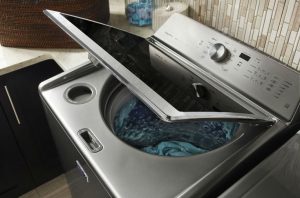1. Washer Will Not Fill With Water
Obviously, a washing machine cannot wash clothes without water. A washer that doesn’t fill with water is a huge problem, and can be the result of various issues.
First, you should check that the house’s water supply to the washer is operating. If it is, you may have an issue with the washer’s water inlet valves. These valves can be easily replaced if they are not functioning properly. Washers that do not fill may also have issues with their pressure switches, temperature selector switches, door lock assembly, or main electronic control board. It can be difficult to diagnose the cause of this problem, as there are so many potential causes, and enlisting a professional washer repair service will help you solve the problem fast.
2. Washer Overfills With Water
A washer that overfills with water is even worse than a washer that will not fill, as it can ultimately flood your laundry room.
Like washers that will not fill, washers that overfill are often caused by problems with the water inlet valve assembly or the water level pressure switch. The pressure switch detects and controls water levels, and a defective switch can cause your washer to overfill. Similarly, the inlet valve system controls the fill function of your appliance, and valves that will not close can cause the unit to overfill. Both of these components can be replaced if need be. You may also be experiencing issues with the washer’s main electronic control board, which controls the fill valves and a host of other parts.For assistance in replacing your washer’s components, be sure to contact a professional appliance repair service.
3. Washer Is Leaking Water
A leaky washer can damage your floor and other nearby appliances, causing a host of problems in your home. This issue is particularly common with front load washers, which can leak from the door and dump massive amounts of water.
A leaking washer can be the result of faulty or damaged water supply hoses. You should ensure these hoses are firmly connected to the back of your washer to ensure there is no leaking. Leaks can also be caused by clogged drain systems, which prevent water from draining. If you have a front load washer, be sure to check the folds in the door boot to ensure there is not a hole that is leaking water. Leaks can also be caused by damage to the outer washtub. Professional appliance repair technicians can help you solve any of these problems should you need assistance.
4. Washer Is Not Spinning
The spinning motion of a washer is vital to the cleaning process, and a washer that doesn’t spin cannot clean clothing.
If your washer’s door does not close properly, or if its door switch does not work, then it will not spin. Be sure to investigate the door and door switch first, as door problems can be solved fairly easily. Another common cause of this issue is a broken or loose motor belt. When the belt is loose or broken, you can hear the washer’s motor running even though the wash drum does not spin. Replacing the faulty belt should resolve the issue.
You may also have a more serious problem with the washer’s transmission or clutch, or possible issues with the dryer’s glides, pulley, or drum rollers. These problems are difficult to solve on your own, and often require expert appliance repairmen to fix.
5. Washer Is Vibrating Too much
It is not uncommon for old washers or low-end units to vibrate slightly while in operation. However, if your appliance vibrates excessively, there may be a bigger problem.
Your washer is likely to vibrate if it is unbalanced. This can be caused by particularly bulky loads of laundry, which get weighed down by water during cycles and cause your unit to toss back and forth. If your washer only occasionally vibrates excessively, this is probably the cause.
A vibrating washer can also be the result of an unbalanced washer. Be sure to inspect around your appliance to ensure it is sitting level on the floor, and that each of the appliance’s feet are locked in place. If your appliance is level and continues to vibrate excessively, you may have a larger problem that requires professional appliance repair services.
6. Washer Is Completely Unresponsive
If your washer is completely unresponsive, you should first check that it is plugged in and that the outlet you’re using functions properly. You can test the outlet by unplugging your washer and plugging in another electronic device to see if that device functions. If not, you likely have an issue with the outlet, and may want to contact an electrician for further help.
If the outlet seems to be functioning properly, you probably have an issue with the washer itself. An unresponsive washer is often the result of a malfunctioning electronic control board or motor control board, both of which can be replaced.
However, it’s important to remember that the life for an average washer is around 10 years. If your appliance is this old, you may want to consider replacing it with a newer model. If you’re interested in finding a new machine, you can explore a host of choices with this online collection of premium washers.
Superior Washer Repair Services For the Modern Home
Modern washers bring a range of advanced and innovative features to the home, offering levels of unparalleled performance and convenience to meet all your needs. You cannot complete the laundry process without a properly functioning washer, and there is no reason that you should have to deal with an appliance that doesn’t work. By educating yourself on a range of common washer repair problems, you can better resolve issues with your appliance.
For additional assistance with all your washer repair needs, be sure to contact a professional appliance repair service.
